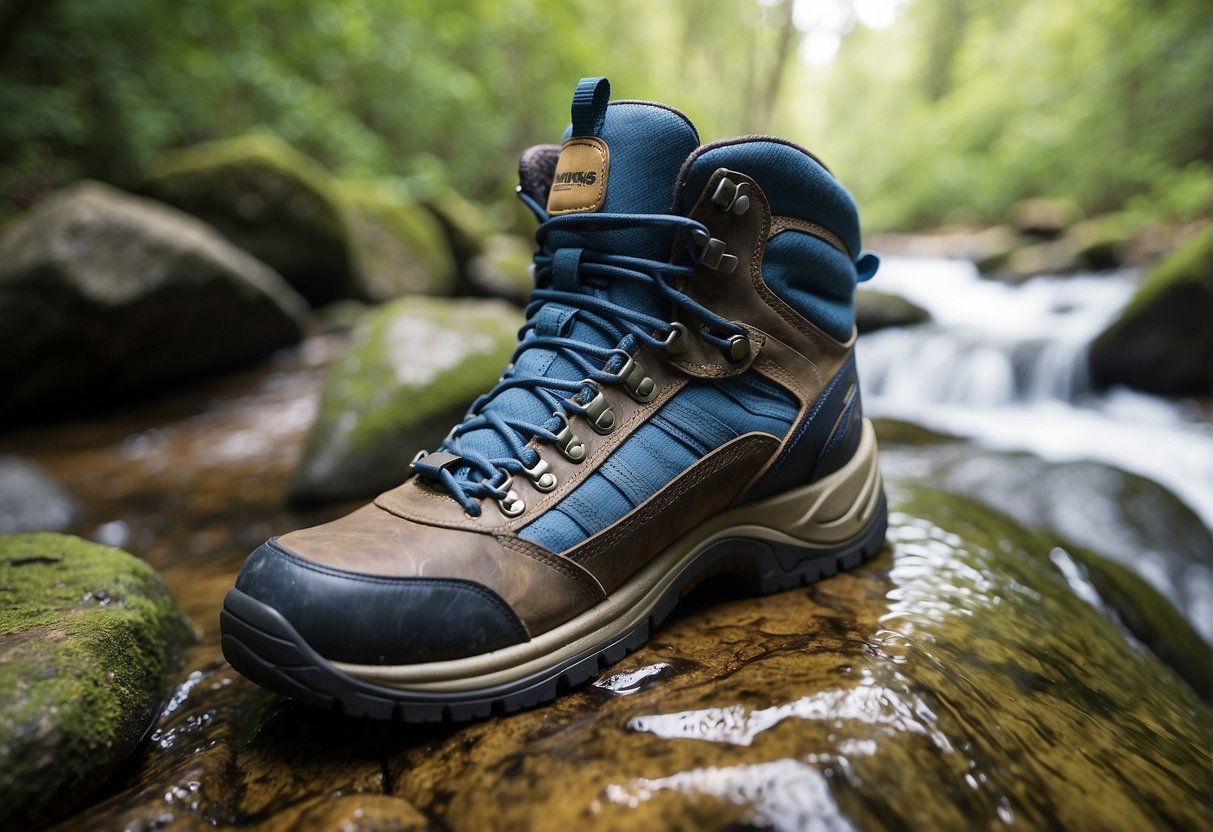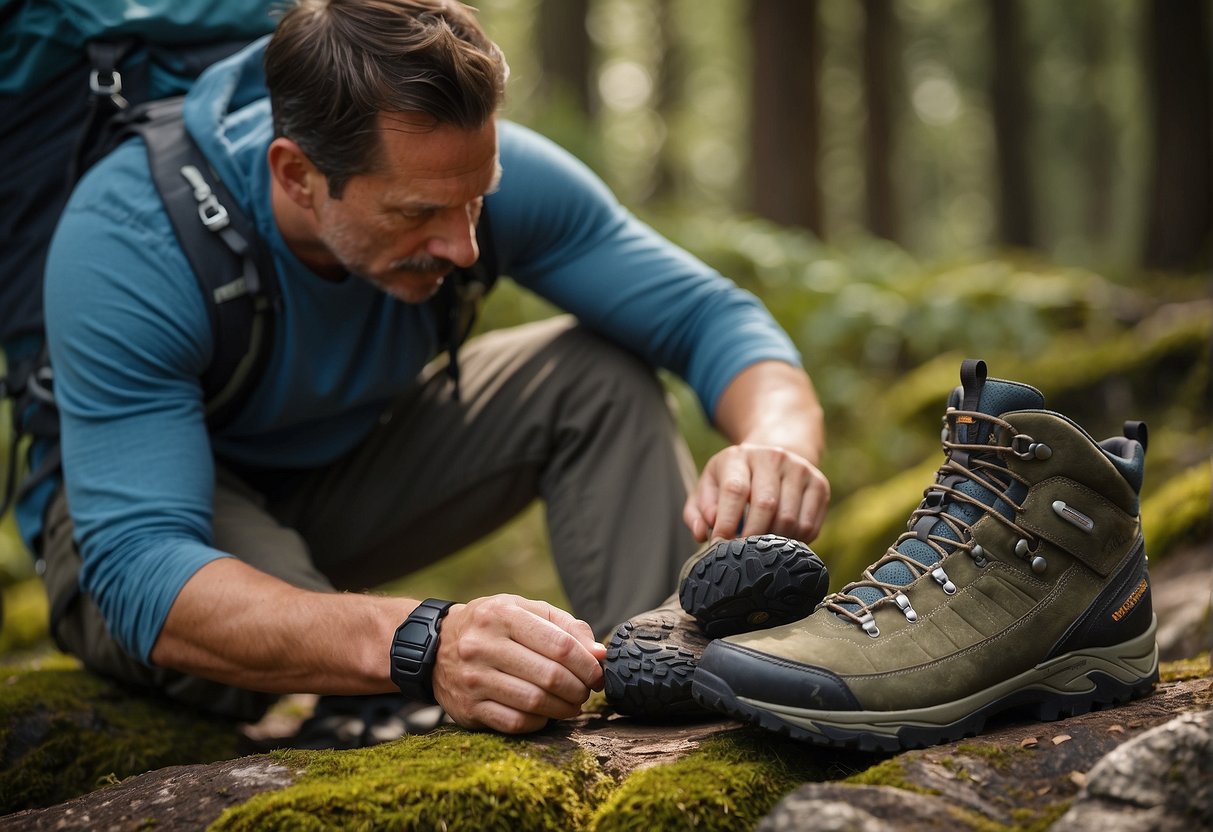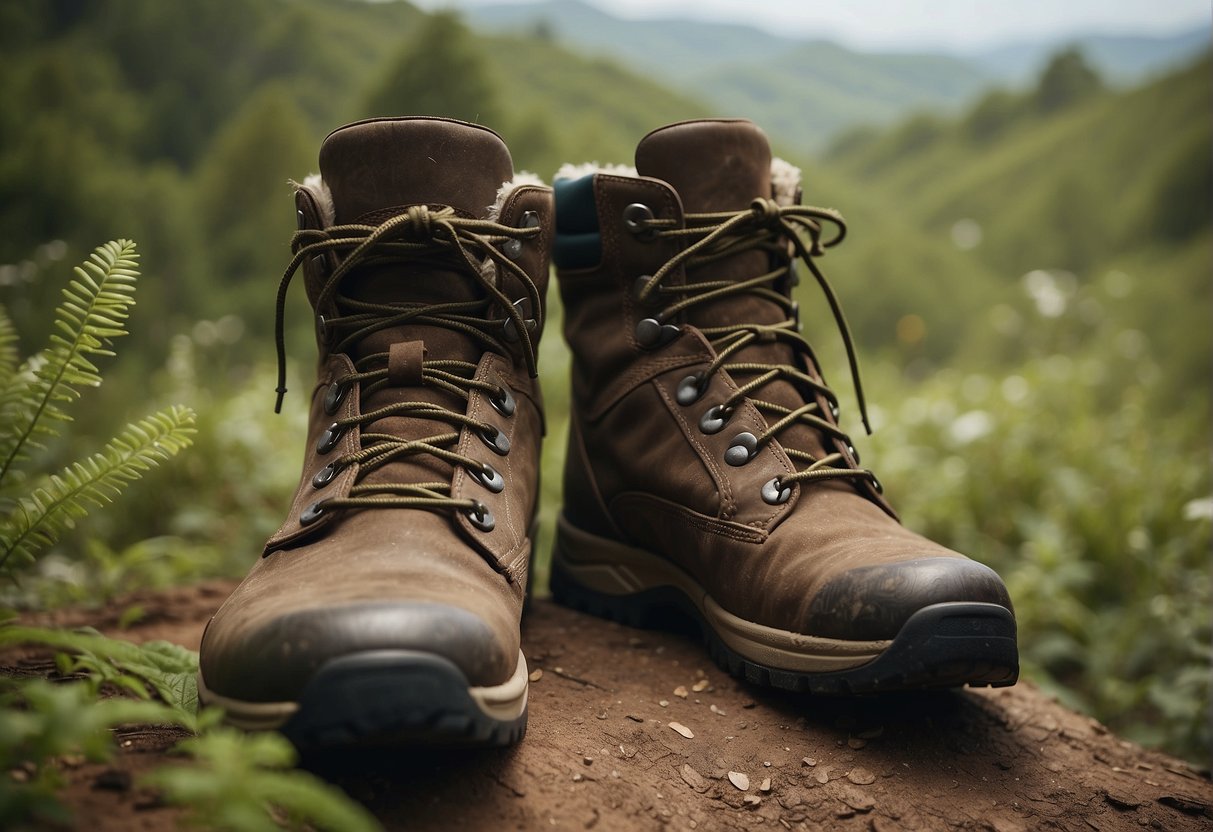As outdoor enthusiasts, we’ve witnessed the stunning beauty of nature, from tranquil forests to rugged peaks. But our adventures come with a responsibility to protect the planet that provides these experiences. That’s why sustainable hiking boots are not just gear; they are a commitment to adventure with respect for the earth. When we lace up boots designed with eco-friendly materials, we’re making a conscious choice to tread lightly and reduce our environmental footprint.

We all know that durable hiking boots are pivotal for safe and comfortable treks. However, choosing boots that are kind to the environment doesn’t mean compromising on quality. Innovative companies are crafting boots utilizing recycled materials, natural fibers, and even vegan alternatives to ensure our gear aligns with our values. By seeking out these sustainable options, we ensure that our love for exploration goes hand in hand with conservation efforts.
Our gear choices reflect the impact we want to have on the world. With each step taken in sustainable hiking boots, we forge a path towards a greener future, one adventure at a time. It’s an invitation to join a growing movement of responsible adventurers who believe the best views come with leaving the smallest footprints. Let’s embrace the journey toward sustainability together, ensuring the trails we love are preserved for generations to come.
Understanding Sustainable Hiking Boots
When we think about hitting the trails, sustainable hiking boots become an essential part of our gear. They not only support our feet but also help us step lightly on the earth.
What Makes Hiking Boots Sustainable?
Sustainable hiking boots are distinguished by their materials and their overall impact on the environment. Key aspects include:
- Sustainable Materials: These boots are often made with recycled materials such as rubber for the outsoles and natural or organic fibers for the upper parts. Brands like Patagonia are known for using recycled parts in their boots, minimizing the reliance on virgin materials.
- Eco-Friendly Production: Sustainable boots are produced in a way that reduces water and energy consumption. This holistic approach also looks at the manufacturing process, ensuring that it has a minimal environmental footprint.
- Durability: Longevity is crucial. A durable pair of boots means less waste, as they won’t need to be replaced as often, translating to fewer boots in landfills.
Importance of Sustainability in Footwear
Sustainability in footwear is vital due to the significant environmental impact the production and disposal of boots can have. Footwear often contains plastics and non-biodegradable materials, which accumulate in landfills. By choosing sustainable hiking boots, we:
- Reduce Waste: With over 300 million pairs of shoes thrown away annually in the US, boots made from recycled or sustainable materials can substantially decrease this number.
- Conserve Resources: By utilizing sustainable materials, we lessen the depletion of natural resources, protecting nature and ensuring it remains for future generations of hikers.
- Promote Healthier Ecosystems: Through the use of eco-friendly materials such as organic leather, we minimize harmful chemicals and processes that can damage ecosystems.
Incorporating eco-friendly practices into the production of hiking boots is not just a trend; it’s a commitment to preserving our beloved trails and the planet as a whole.
Key Features of Sustainable Hiking Boots

When we look for sustainable hiking boots, we’re not just thinking about protecting our feet on the trails. We’re considering how we can reduce our environmental footprint with every step. Let’s explore the innovations and considerations that make a hiking boot truly sustainable.
Material Innovations
Sustainable hiking boots often start with material choices. Manufacturers are adopting sustainable materials such as recycled polyester, natural rubber, and even hemp. These materials provide excellent performance while being kinder to the environment. For example, some boots are made using synthetic, natural, and recycled materials to enhance durability without relying on traditional leather, which aligns with vegan principles.
- Recycled Polyester: Often sourced from plastic bottles, it’s used in laces and linings.
- Hemp: A durable and breathable fabric that makes for eco-friendly hiking boots.
- Natural Rubber: Harvested sustainably, it’s used in soles for flexibility and grip.
Design and Style Considerations
The design of sustainable hiking boots doesn’t compromise on quality or style. Comfort and support are paramount, ensuring that the boots are not only environmentally friendly but also suitable for various terrains and hiking needs. The aim is to merge aesthetic appeal with functional design.
- Comfort: Use of cushioned insoles and ergonomic fits.
- Support: Ankle support and traction studs for stability.
Durability and Longevity
A fundamental aspect of sustainability is durability. Durable hiking boots are designed to last longer, meaning less frequent replacements and reduced waste. Look for boots with waterproof boots protection and quality construction to withstand the elements, whether you’re a seasoned hiker or a beginner. Boots that can be repaired extend their lifespan even further, true to sustainable goals.
- Quality Construction: Double-stitched seams and strong bonds.
- Waterproofing: Durable water-repellent treatments to keep feet dry.
Top Brands and Models
When we look for sustainable hiking boots, we’re seeking a balance between function and care for the environment. Let’s explore the brands leading the way and compare some of the most popular models on the market.
Leading Eco-Friendly Brands
- Merrell: A champion of the movement, Merrell is part of the Sustainable Apparel Coalition, ensuring transparency in their production practices.
- Salomon: Known for their performance and quality, Salomon’s commitment is evident in their range of sustainable options at various price points.
- Allbirds: With their utilization of natural materials like merino wool and eucalyptus fiber, Allbirds has become synonymous with eco-conscious footwear choices.
- Vivobarefoot: Their pursuit of sustainability includes crafting boots using recycled PET, upholding both quality and ecological responsibility.
- Leather Working Group: Brands associated with this group, like Lowa, commit to environmentally responsible leather production, elevating the standard for sustainable leather hiking boots.
Comparing Popular Sustainable Models
- Merrell Moab 2 Ventilator: A durable choice, leveraging a combination of recycled materials and sustainably sourced leather.
- Salomon X Ultra 3: Highly regarded for its superior traction and eco-friendly design, it’s a boot that delivers on all fronts.
- Allbirds Trail Runner SWT: Light on the feet and the environment, this model proves that sustainability doesn’t compromise performance.
- Vivobarefoot Tracker FG: For those who want to feel the ground beneath their feet, this minimalist option from Vivobarefoot uses recycled materials without neglecting durability.
The Environmental Impact of Hiking Boots

When considering our trek through nature, it’s essential that we choose sustainable hiking boots that tread lightly on the earth.
The Problem with Fast Fashion
Fast fashion, the rapid production of inexpensive clothing, including conventional hiking boots, relies heavily on non-renewable resources. Plastics, a common material found in footwear, often end up in landfills or as marine plastic, imposing a significant burden on our environment.
Reducing Carbon Footprint
To work towards a greener planet, many companies are pursuing carbon neutral goals, implementing carbon offset programs, and creating products that align with the circular economy. By wearing hiking boots that are climate neutral certified, we’re effectively taking steps to minimize our carbon footprint at every trail we conquer.
Ensuring Comfort and Performance

We all want our outdoor expeditions to leave a green footprint without compromising on our personal comfort and performance. That’s why when it comes to choosing sustainable hiking boots, we look for options that stand up to varied terrains and weather conditions while ensuring our feet stay supported and cozy.
Comfort and Cushioning for Different Terrains
When we’re traversing different terrains, from rocky paths to soft soil, the cushioning of our boots becomes crucial. Sustainable hiking boots often utilize materials like recycled EVA midsoles, providing that much-needed padding underfoot. For example, companies like Hoka integrate thick compression-molded EVA midsoles for a springier step, crucial for comfort on long hikes. What’s more, neoprene lining, spotted in brands like Merry People, adds another layer of soft, supportive comfort, especially beneficial for our ankle areas.
- Cushioning Materials:
- Recycled EVA midsoles
- Neoprene lining
Traction and Water Resistance Features
As for tackling slippery slopes or crossing shallow streams, the traction and water resistance of our boots are pivotal. High-quality sustainable hiking boots boast outsoles with traction studs for superior grip – think winter hikes where stability is key. Plus, waterproofing is often achieved through recycled materials that also offer breathability to prevent moisture buildup. Some sustainable options make use of synthetic and natural materials to create barriers against water while allowing airflow to keep our feet dry and comfy.
- Key Features for Performance:
- Traction studs for grip
- Sustainable, waterproof materials
- Breathable designs for moisture control
Sustainability Beyond the Product

When we think about sustainable hiking boots, it’s crucial to consider the full picture—how they’re made and the commitments companies uphold to preserve our planet.
Ethical Production and Supply Chain
Sustainable Supply Chain: To ensure a product is truly sustainable, the entire supply chain must be considered. This includes sourcing materials responsibly, ensuring a living wage is paid to workers, and implementing a fair wage policy across the board. Ethical production means more than just the end product; it involves every hand that touches it, from the source to the store.
Commitment to Fair Practices: Companies like Patagonia and those certified as B Corps take ethical supply chains seriously, adhering to a strict code of conduct. By committing to such standards, these companies make certain that every pair of boots reflects a respect for the people who make them and the environment they’re made in.
Certifications and Standards
Recognized Certifications: Certifications like Bluesign guide the way for sustainable practices in material processing, ensuring that products are made with the smallest environmental footprint possible. When we see these certifications, we can be more confident in the product’s sustainable claims.
Conservation and Giving Back: Beyond certifications, initiatives like 1% for the Planet and the Conservation Alliance show a brand’s dedication to the environment. A brand engaged in these initiatives contributes a portion of their profits to environmental causes, underscoring their commitment to the earth that their boots are made to explore.
Through a combination of ethical supply chains, rigorous standards, and environmental philanthropy, sustainable hiking boots go beyond just eco-friendly materials, aiming to make a positive impact with each step towards a greener future.
Caring for Your Sustainable Hiking Boots

In our journey to preserve the environment, we carefully select our sustainable hiking boots. Ensuring their longevity through proper care is just as crucial as choosing them.
Maintenance Tips
Regular Cleaning: After each hike, we make it a habit to brush off dirt and debris from our boots. Using a mild soap and lukewarm water, we carefully clean the surface. For sustainable leather boots, we use a cleaner specifically designed for leather to maintain its integrity.
Drying: Whenever our boots get wet, it’s important not to speed-dry them. Exposure to high heat can damage the materials, so we opt for air-drying at room temperature, away from direct heat sources.
Waterproofing: Hiking boots may lose their water resistance over time. We regularly apply a waterproofing treatment, suitable for the materials our boots are made from, be it organic materials or sustainable leather.
Storage: We always store our boots in a cool, dry place to prevent the materials from deteriorating. This helps maintain the boot’s durability and overall value.
Repair and Replacement Parts
Identifying Wear: We keep an eye on areas like the soles and laces for signs of wear. Recognizing early signs of damage allows us to address issues before they worsen.
Replacement Parts: When possible, we opt for boots from repairable shoe brands that offer replacement parts. This often includes items like laces, insoles, and sometimes even outsoles.
Professional Repair: For more significant issues, we seek professional repair services. Some sustainable hiking boot brands offer repair programs, reducing the need to replace the entire boot.
By following these guidelines, we ensure that our sustainable hiking boots remain a valuable, long-lasting part of our outdoor gear, matching our commitment to sustainability with action.
Choosing the Right Boots for You

When we embark on our next outdoor adventure, it’s essential to have sustainable hiking boots that align with our values of environmental responsibility while not compromising on comfort or quality.
Fit and Sizing Guidance
Proper fit is crucial for comfort and to prevent injuries. We’ll make sure our sustainable hiking boots fit snugly around the heel, with about a thumb’s width between our toes and the front of the boot. It’s worth considering the socks we plan to wear, as they can affect the boot’s fit. Different brands may vary in sizing, so it’s best to try them on or consult with a fitting expert.
- Heel: Ensure it doesn’t slip.
- Toes: Check for ample space.
- Width: Boots should not feel tight.
Balancing Budget and Quality
While balancing our budget and the quality of hiking boots, it’s crucial to remember that higher-priced boots often provide better value over time. Durability and the use of sustainable materials can mean spending less in the long run due to fewer replacements. To align with both our economic and ecological goals, we’ll look for boots that blend eco-friendly materials with a reputation for longevity and performance.
- Budget-friendly: Compare options within our budget.
- Long-term value: Consider cost-per-wear and durability.
Remember, the weight and style of the boot also play roles in our hiking experience. Lightweight designs can reduce fatigue, and a style that resonates with our personal tastes can make our sustainable choice even more satisfying.
The Future of Sustainable Footwear

As we explore the evolving landscape of sustainable hiking boots, let’s delve into the innovations set to redefine our trails and the critical role our choices play in shaping the industry.
Innovations on the Horizon
The journey toward sustainability is getting a new lease on life with innovative materials and processes. Biocircular™ materials are emerging, transforming the lifecycle of boots by allowing materials to be reused rather than discarded. Companies like Wolverine Worldwide are looking ahead, investing in technologies that promise a future where boots are not just made to last, but also to live on in new forms.
- Recycled Materials: The use of plastics, rubber, and textiles from recycled sources is becoming increasingly common.
- Carbon Neutrality: A push towards CarbonNeutral® production is on the rise, aiming to offset the carbon footprint of boot manufacturing.
- Sustainable Fashion Testing: Rigorous testing by industry experts, such as senior editors from prominent outdoor publications, ensures that upcoming boots are not only eco-conscious but also high in quality.
The Role of Consumer Choices
Our individual choices have always had power, but in the context of sustainable hiking boots, they can direct the future of the fashion industry. By choosing sustainable options, we signal a demand for products that value longevity over disposability, counteracting the fast fashion trend. Kids, too, are becoming a focal point, with parents looking for sustainable fashion that supports a greener planet for future generations.
- Supporting Responsible Brands: When we support brands that prioritize sustainability, like REI, we contribute to a larger shift in industry practices.
- Education and Advocacy: As consumers, we play the role of both learners and teachers, advocating for sustainable practices within our communities.
Our collective footsteps can leave a gentle imprint on the earth, one pair of sustainable hiking boots at a time.
Why Sustainable Hiking Boots Are So Important

We all love the great outdoors, and maintaining its beauty is crucial. That’s where sustainable hiking boots come into play. By choosing eco-friendly options, we minimize our environmental footprint and support conservation efforts with every step we take on the trail.
- Materials: Traditional boots may use materials that are not environmentally friendly. Sustainable hiking boots, on the other hand, prioritize materials that are either recycled or sourced with minimal impact on the environment.
- Manufacturing: The production process of sustainable boots often consumes less energy and water. This reduces greenhouse gases and conserves vital resources.
- Longevity: Quality often goes hand-in-hand with sustainability. Durable boots mean we buy less over time, reducing our overall consumption and waste.
- Biodegradability: At the end of their life cycle, boots made with biodegradable materials will break down more naturally, lessening landfill impact.
Sustainable hiking boots not only guide us along paths and protect our feet, they also safeguard the trails we cherish. By investing in eco-friendly boots, we’re casting a vote for the planet. Good for our feet and kind to Earth — sustainable footwear is a step towards preserving nature for future generations.
Frequently Asked Questions
We often get asked about the ins and outs of sustainable hiking boots. So, let’s tackle some common queries to help you make informed choices.
What are the leading brands offering eco-friendly hiking boots?
Several top brands are pioneering the move towards eco-conscious gear. Patagonia, for example, uses recycled materials in their footwear, aiming to decrease waste and environmental impact.
How do sustainable hiking boots compare with traditional ones in terms of durability?
Sustainable hiking boots are now rivalling traditional boots in terms of longevity. Many eco-friendly options use high-quality, durable materials designed to withstand rigorous use just like any other high-performance boot. Choosing well-crafted sustainable boots means you won’t be sacrificing durability for eco-friendliness.
What materials should I look for in environmentally friendly hiking boots?
Look for materials such as recycled rubber for the outsoles, eco-friendly EVA for cushioning, and certified organic or recycled fabrics for the upper parts of the boots. Some brands also offer boots made from sustainably sourced leather or synthetic alternatives.
Can you recommend sustainably made hiking boots that are suitable for women?
Yes, several brands offer women’s sustainable hiking boots designed for a comfortable fit and excellent performance. Like Patagonia
What features are important to consider when choosing sustainable hiking footwear?
Key features to consider include a comfortable fit, adequate support, breathability, water resistance, and the type of traction provided by the outsoles. Also important is the boot’s construction quality which contributes to both its durability and environmental impact.
Are there any hiking boot options that balance both sustainability and performance for weekend hikes?
Certainly! Many sustainable hiking boots are designed to offer excellent performance without compromising on eco-friendliness. They’re durable, offer good support, and are made using sustainable practices, making them perfect for weekend hikes.
Sustainable hiking boots are a growing trend in the outdoor industry, with more brands recognizing the importance of minimizing environmental impact. These boots are crafted with eco-friendly materials and ethical production practices, providing a responsible choice for environmentally conscious hikers.
As the demand for sustainable outdoor gear increases, we’d love to hear your experiences with eco-friendly hiking boots. Comment below to share the brands you’ve tried, the quality of the materials, and how the boots have performed on the trail. Have you noticed a difference in durability or comfort compared to traditional hiking boots? Your insights can guide others who are looking to make more sustainable choices in their outdoor gear. Let’s discuss the intersection of environmental responsibility and outdoor adventure, and help each other make choices that protect the trails we love to explore.
-Your Advntur-Team 🙂

